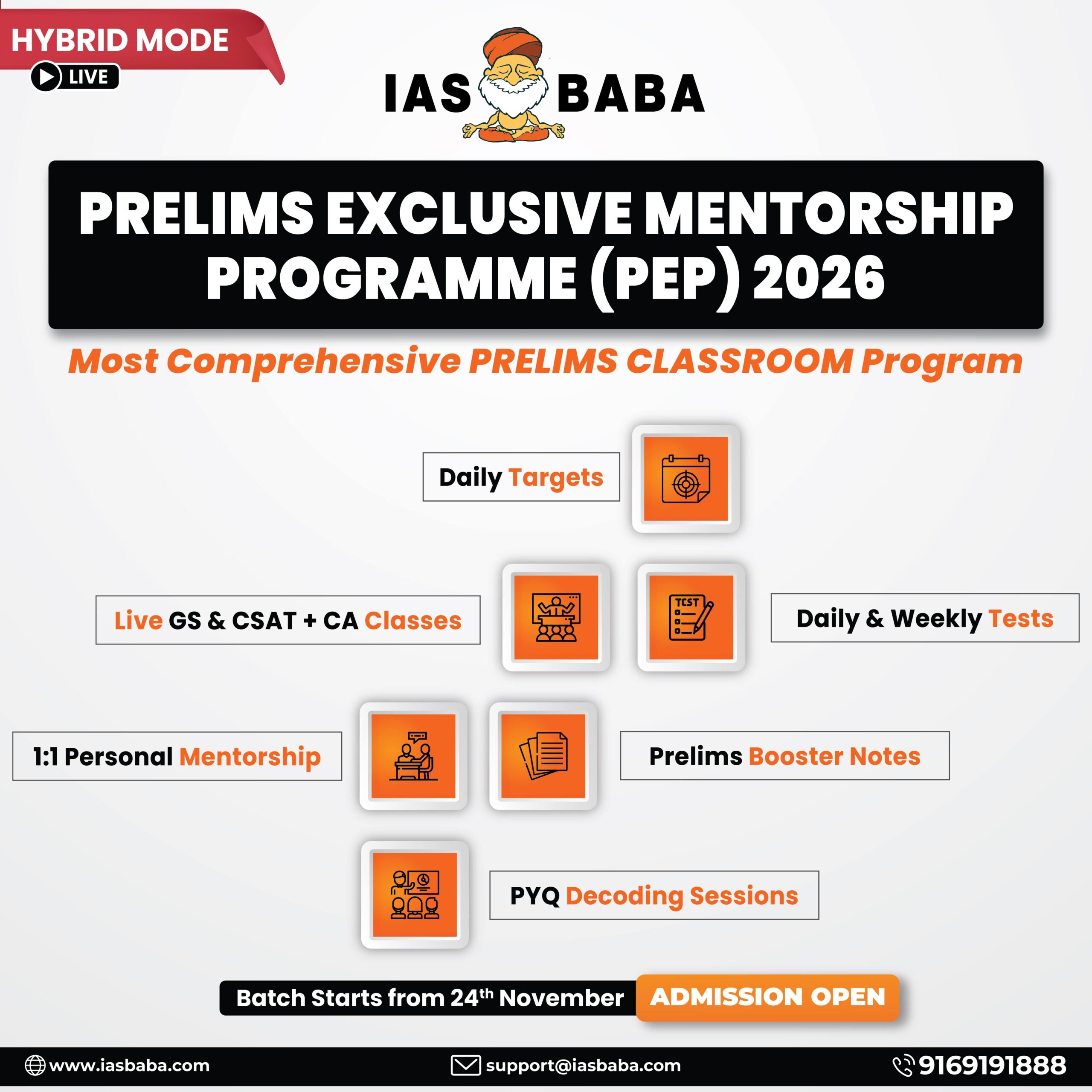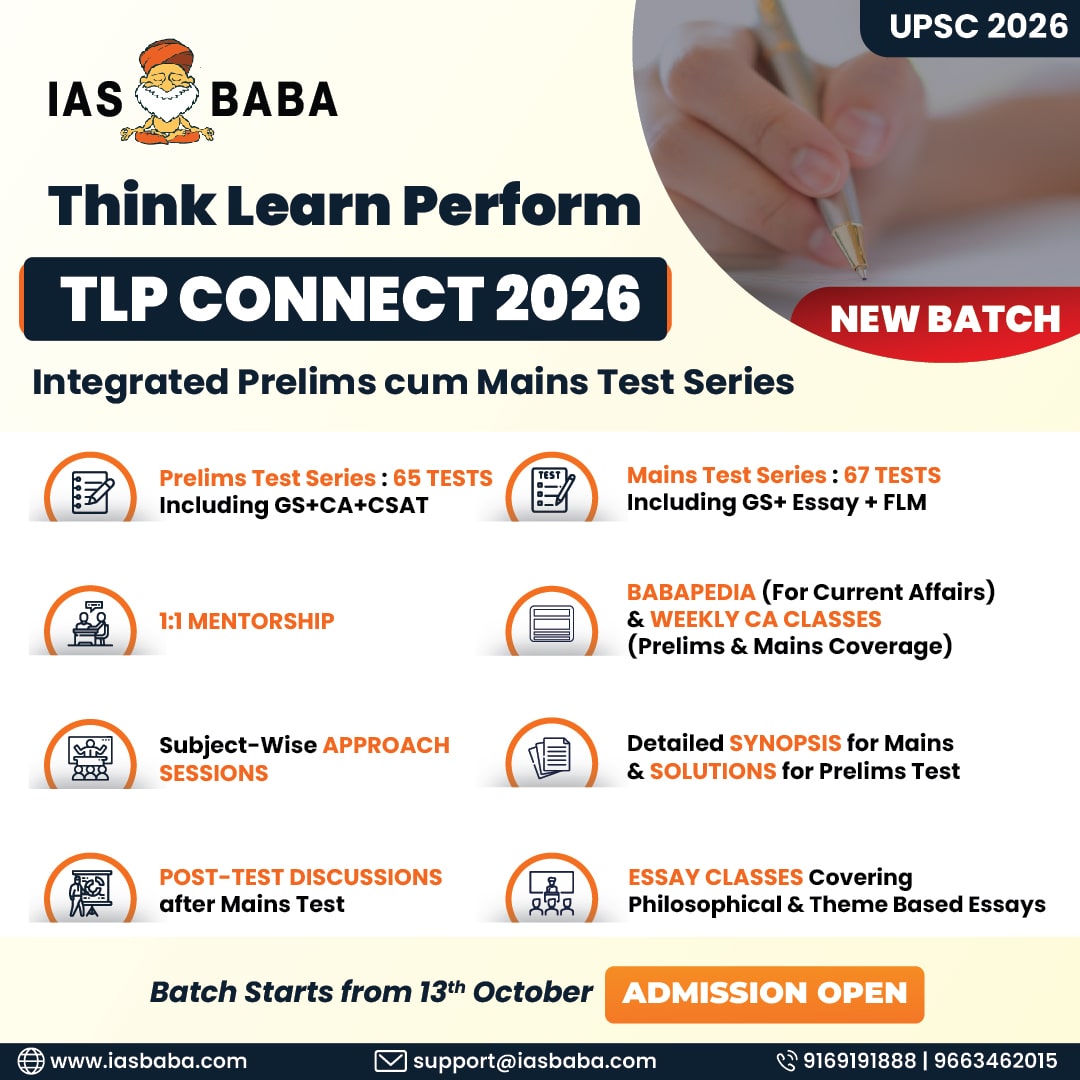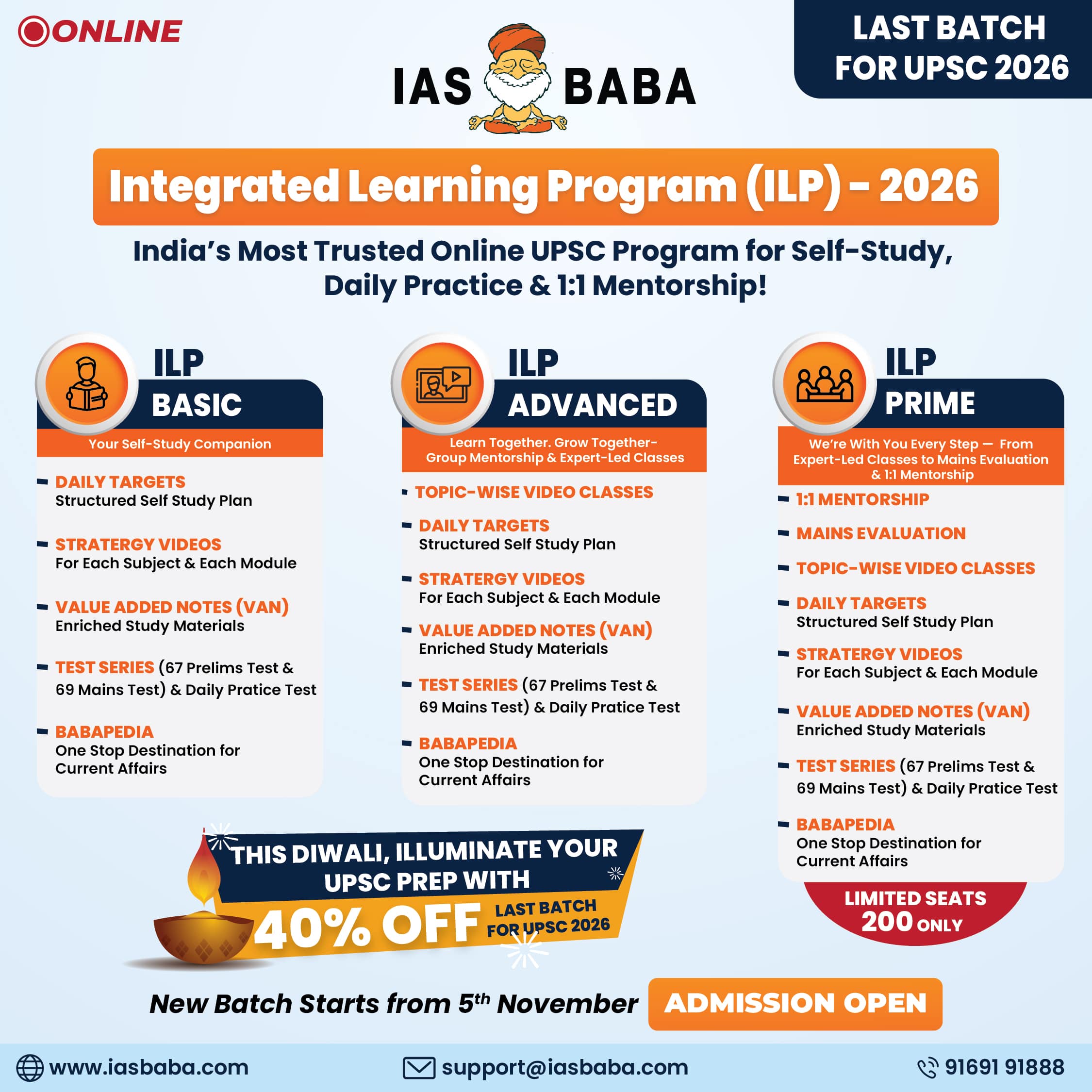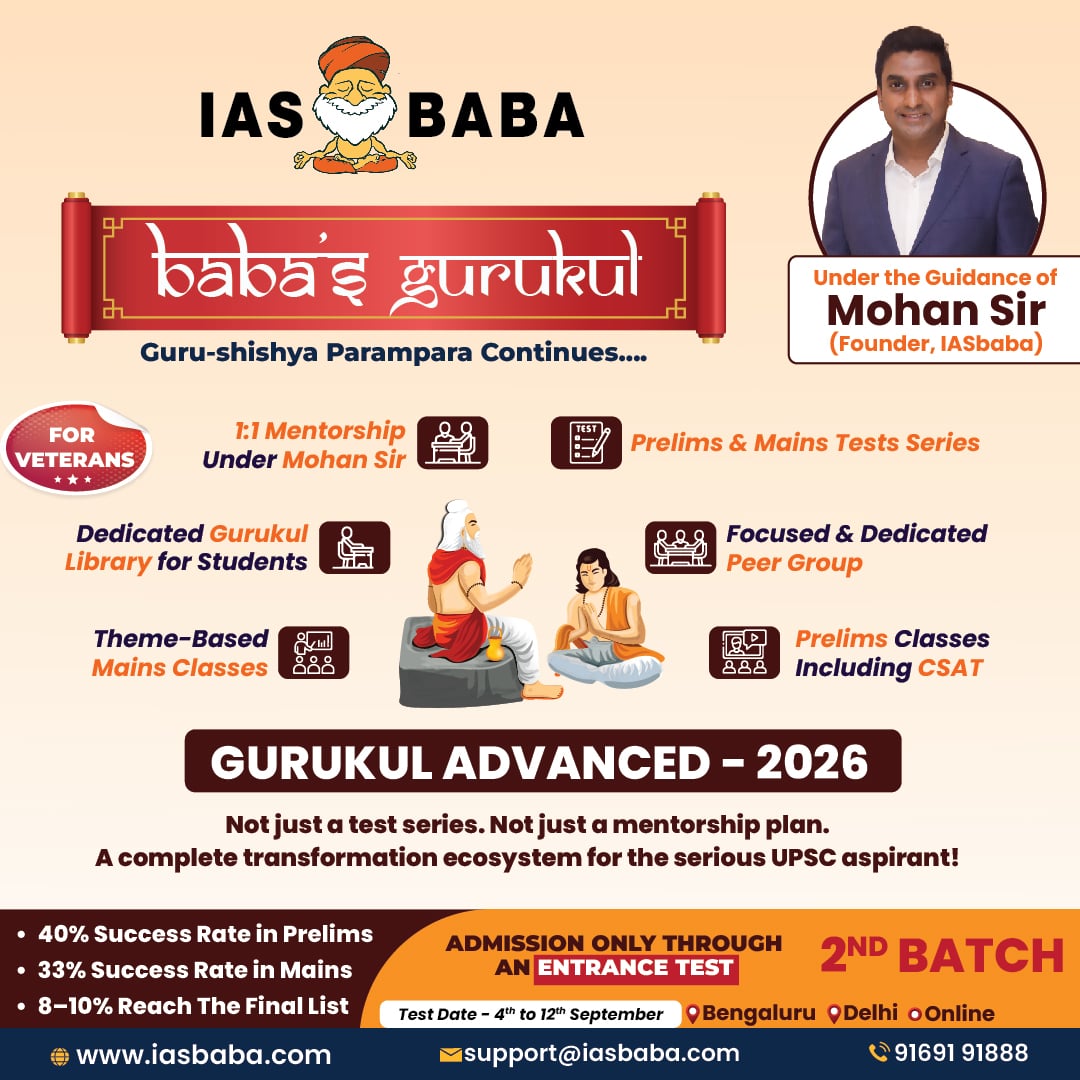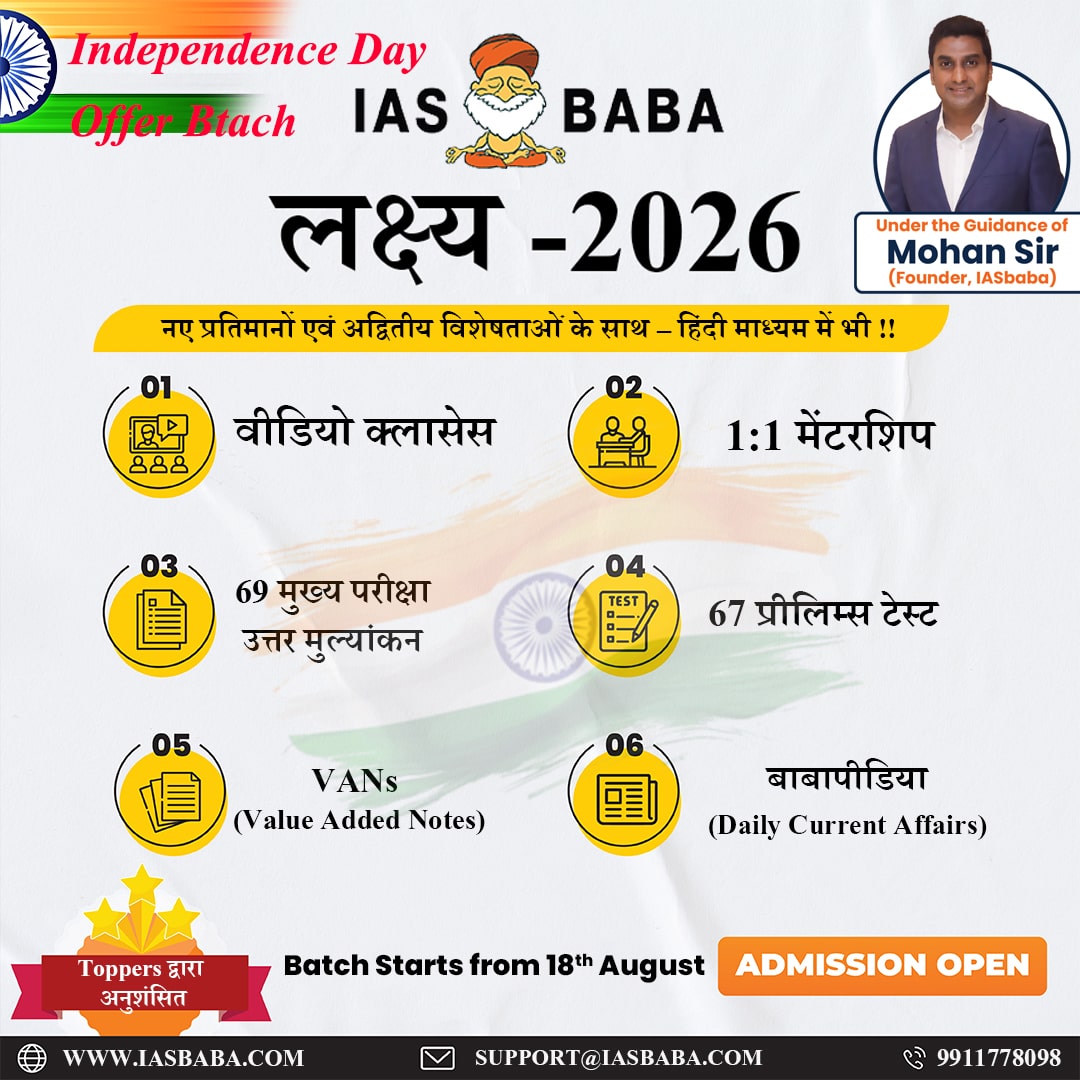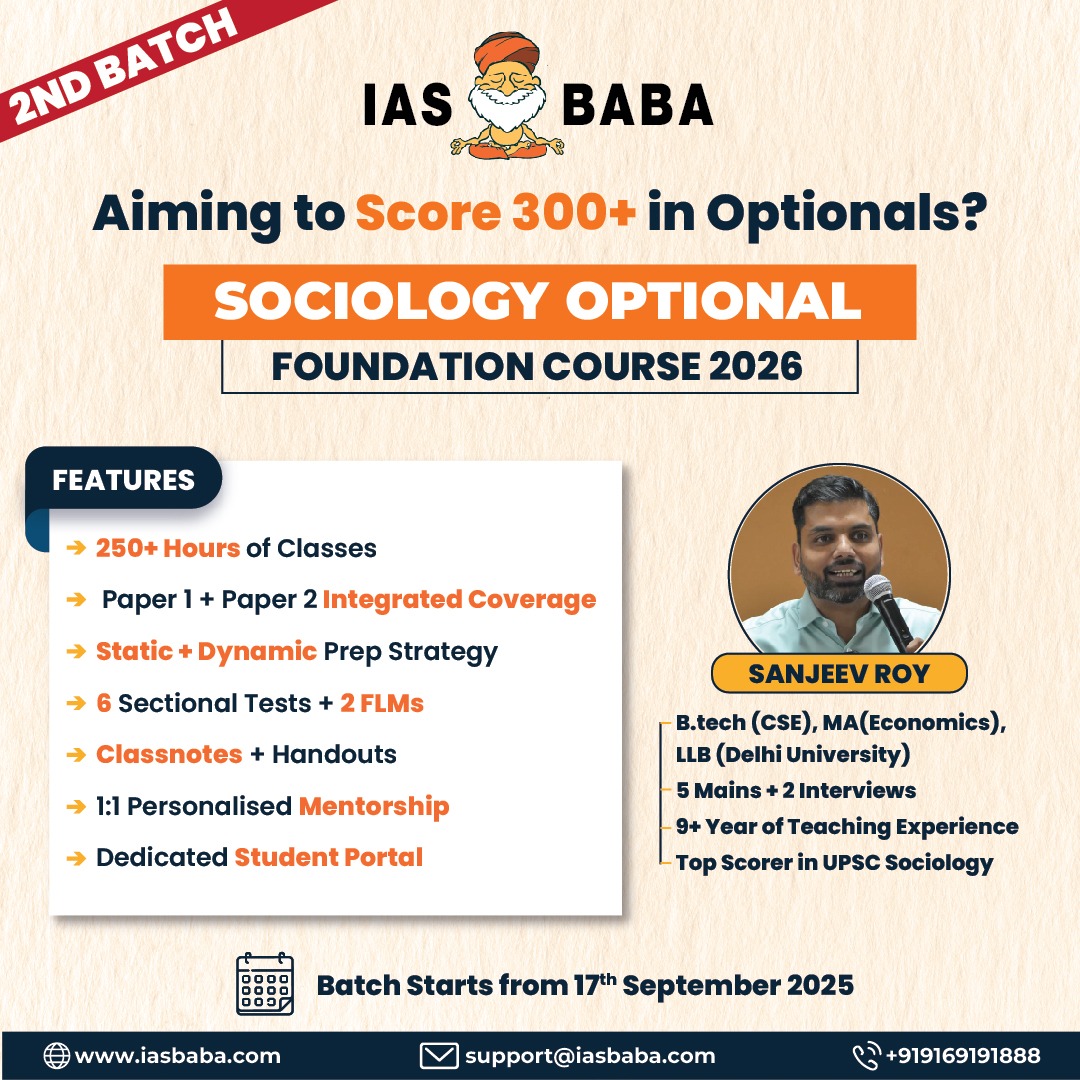IASbaba's Daily Current Affairs Analysis
Archives
(PRELIMS Focus)
Category: SCIENCE AND TECHNOLOGY
Context: Technique to Make CAR T-Cells In Vivo Could Transform Cancer Care
Decoding Context:
Overview
- CAR T-cell therapy retrains immune cells (T-cells) to recognize and destroy cancer cells by inserting synthetic genetic instructions for a molecule called CAR (chimeric antigen receptor).
- A major advancement now allows scientists to engineer CAR T-cells inside the body (in vivo) instead of the traditional complex and expensive lab processing.
Key Innovation
- A new method uses mRNA-loaded lipid nanoparticles (LNPs) to deliver CAR gene instructions directly into the bloodstream, targeting CD8+ T-cells, enabling them to fight cancers like B-cell lymphoma.
- This avoids viruses and ex vivo processing, reducing risks like immune system suppression and genetic side effects.
Advantages
- Cost-effective: Conventional CAR T-cell therapy costs ₹60–70 lakh; the new platform is significantly cheaper.
- Efficient & quicker: Lipid nanoparticles (like Lipid 829) show faster response, reduced inflammation, and eliminate the need for harvesting and manipulating cells in the lab.
- Scalable & accessible: Easier to implement in resource-limited settings like India.
Preclinical Success
- In monkey trials, treatment showed up to 85–95% tumor clearance.
- Mice also showed effective tumor regression with different targeting (CD20, CD19).
- CAR T-cells were generated in vivo and worked without requiring preconditioning regimens.
Risks & Safety
- Reduced risks compared to virus-based methods.
- However, one monkey had a severe reaction similar to hemophagocytic lymphohistiocytosis (HLH), underscoring the need for careful dosing and clinical monitoring.
Implications for India
- India faces a growing burden of B-cell cancers and autoimmune disorders.
- The new platform could provide affordable and scalable therapy, bypassing infrastructure challenges.
- If clinical trials succeed, it may revolutionize treatment for both cancer and immune diseases.
Learning Corner:
CAR-T Therapy (Chimeric Antigen Receptor T-cell Therapy)
CAR-T therapy is a type of immunotherapy that uses specially modified T-cells (a type of white blood cell) to fight cancer.
What is CAR-T?
- CAR-T stands for: Chimeric Antigen Receptor T-cell.
- It involves genetically engineering a patient’s own T-cells to express receptors (CARs) that can recognize and bind to specific proteins on cancer cells.
How It Works:
- T-cell Collection: T-cells are collected from the patient’s blood.
- Genetic Modification: In a lab, these T-cells are modified to produce CARs on their surface.
- Cell Multiplication: The modified cells are multiplied in large numbers.
- Reinfusion: These engineered CAR-T cells are infused back into the patient.
- Attack Cancer: The CAR-T cells identify and kill cancer cells carrying the target antigen.
Applications:
- Effective mainly for blood cancers such as:
- B-cell Acute Lymphoblastic Leukemia (ALL)
- Diffuse Large B-cell Lymphoma (DLBCL)
- Multiple Myeloma
- Clinical trials are ongoing for solid tumors.
CAR-T in India:
- India’s first indigenously developed CAR-T therapy is “NexCAR19”, jointly developed by IIT Bombay and ImmunoACT, launched in 2024.
- It significantly reduces cost compared to global CAR-T therapies.
Challenges:
- High cost and complex manufacturing
- Risk of cytokine release syndrome (CRS) and neurological side effects
- Limited success so far in solid tumors
Source: THE HINDU
Category: POLITY
Context: The Emergency in India, declared on 25 June 1975 and lasting until 21 March 1977
National Emergency (Article 352 of the Indian Constitution)
A National Emergency is a constitutional provision under Article 352 that allows the central government to assume sweeping powers in case of grave threats to the nation’s security.
Grounds for Proclamation:
National Emergency can be proclaimed by the President of India on the following grounds:
- War
- External Aggression
- Armed Rebellion (added by the 44th Amendment; replaced “internal disturbance”)
Procedure:
- Must be based on a written recommendation of the Union Cabinet (not just the PM).
- Must be approved by both Houses of Parliament within 1 month.
- Once approved, it remains in force for 6 months and can be extended indefinitely with six-monthly parliamentary approvals.
- Special majority is required in Parliament for continuation.
Effects of National Emergency:
- Federalism weakened: Centre can give directions to states on any matter.
- Fundamental Rights (Article 19): Can be suspended during Emergency due to war/external aggression (not for armed rebellion).
- Article 358: Automatically suspends Article 19.
- Article 359: Allows suspension of enforcement of other rights (except Article 20 & 21 after 44th Amendment).
- Lok Sabha tenure: Can be extended by 1 year at a time (maximum 6 months after Emergency ends).
Instances in Indian History:
- 1962 – Indo-China War (External Aggression)
- 1971 – Indo-Pak War (War)
- 1975–1977 – Declared by Indira Gandhi (Internal Disturbance); most controversial
Constitutional Safeguards (44th Amendment, 1978):
- “Internal disturbance” replaced with “armed rebellion”.
- Cabinet approval in writing made mandatory.
- Fundamental Rights under Articles 20 and 21 cannot be suspended.
Learning Corner:
Types of Emergencies in the Indian Constitution
President’s Rule (State Emergency) – Article 356
Ground:
- Failure of constitutional machinery in a state
Key Features:
- Invoked when Governor reports breakdown of state governance
- President takes over state functions
- Parliament legislates for the state
- Needs Parliamentary approval within 2 months
- Valid for 6 months, extendable up to 3 years with conditions
- Widely misused in early decades; restricted post SR Bommai case (1994)
Financial Emergency – Article 360
Ground:
- Threat to financial stability or credit of India
Key Features:
- Declared by the President
- Needs Parliamentary approval within 2 months
- Never used so far
- Centre can reduce salaries, including those of judges and civil servants
- Can direct states to follow financial propriety measures
Comparison Table
| Type | Article | Grounds | Approval Needed | Used? |
|---|---|---|---|---|
| National Emergency | 352 | War, External Aggression, Armed Rebellion | Yes (Both Houses) | 3 times |
| President’s Rule | 356 | State machinery failure | Yes | 100+ times |
| Financial Emergency | 360 | Financial instability | Yes | Never |
Source: THE INDIAN EXPRESS
Category: INTERNATIONAL
Context India has entered the top 100 in the United Nations Sustainable Development Goals (SDG) rankings for the first time, securing the 99th position out of 193 countries in the 2025.
Key Highlights:
- Current Rank (2025): 99th
- Previous Ranks: 109th (2024), 112th (2023), 121st (2022)
- SDG Index Score: 67
- Regional Comparison: Ahead of Bangladesh (114th), Pakistan (140th); behind Maldives (53rd), Bhutan (74th), Nepal (85th), Sri Lanka (93rd)
Reasons for Improvement:
- Progress in poverty reduction, clean energy access, healthcare, housing, and infrastructure.
- Effective implementation of government welfare schemes.
- Strong regional momentum in South and East Asia.
Global Context:
- Only 17% of SDG targets are on track globally, with progress hindered by conflict, economic instability, and climate crises.
- India’s progress is crucial due to its large population and developmental influence.
Learning Corner:
Sustainable Development Goals (SDGs)
The Sustainable Development Goals (SDGs) are a universal call to action adopted by all United Nations Member States in 2015 as part of the 2030 Agenda for Sustainable Development. There are 17 goals and 169 targets aimed at ending poverty, protecting the planet, and ensuring peace and prosperity for all by 2030.
Key Features:
- Adopted at the UN Sustainable Development Summit (2015) in New York.
- Succeed the Millennium Development Goals (MDGs) (2000–2015).
- Apply equally to developed and developing countries—“No one left behind.”
- Cover social, economic, and environmental dimensions of development.
List of 17 SDG Goals:
- No Poverty
- Zero Hunger
- Good Health and Well-being
- Quality Education
- Gender Equality
- Clean Water and Sanitation
- Affordable and Clean Energy
- Decent Work and Economic Growth
- Industry, Innovation and Infrastructure
- Reduced Inequalities
- Sustainable Cities and Communities
- Responsible Consumption and Production
- Climate Action
- Life Below Water
- Life on Land
- Peace, Justice and Strong Institutions
- Partnerships for the Goals
SDGs in India:
- NITI Aayog monitors progress through the SDG India Index.
- Focus areas include poverty eradication, women empowerment, renewable energy, sanitation, and digital access.
- In 2025, India ranked 99th globally in SDG progress, entering the top 100 for the first time.
Source : THE HINDU
Category: ENVIRONMENT
Category: HISTORY
Context: A rare 15th-century sculptural lamp has been unearthed at the Anantapadmanabha Temple in Perdur, Udupi district, Karnataka
The lamp stands out for its intricate artwork that fuses Shaiva and Vaishnava iconography, reflecting the syncretic religious traditions of medieval Karnataka.
Key Highlights:
- Location: Anantapadmanabha Temple, Udupi, Karnataka
- Estimated Age: 15th century
- Iconography: Features elements from both Shaivism and Vaishnavism, illustrating mythological tales
- Cultural Value: Highlights the peaceful coexistence and mutual respect between different Hindu sects
- Artistic Significance: Provides insights into temple art, religious life, and devotional practices of the era
This find enriches our understanding of the temple heritage and religious art of the region, underlining Udupi’s longstanding cultural and spiritual significance.
Learning Corner:
15th-Century Architecture in India
The 15th century in India was a period of regional kingdoms, marked by a rich blend of indigenous styles and emerging Islamic influences. Architectural developments during this era reflected both religious devotion and political power.
Key Architectural Styles of the 15th Century:
Vijayanagara Architecture (South India)
- Flourished under the Vijayanagara Empire (1336–1646).
- Features:
- Massive gopurams (temple towers)
- Monolithic sculptures (e.g., Nandi at Lepakshi)
- Ornate mandapas (pillared halls)
- Use of granite and carved pillars
- Notable Sites: Hampi, Virupaksha Temple, Vittala Temple
Indo-Islamic Architecture (North and Central India)
- Advanced under Delhi Sultanate and Bahmani, Gujarat, and Malwa Sultanates.
- Features:
- Arches, domes, and minarets
- Use of red sandstone and marble
- Geometric and floral motifs, Persian calligraphy
- Notable Examples:
- Jama Masjid (Champaner), Gol Gumbaz (Bijapur) (early form)
Rajput Architecture
- Continued to build forts and palaces with Hindu symbolism.
- Features:
- Chhatris (dome-shaped pavilions)
- Decorative brackets and balconies
- Temples with Nagara-style spires
- Sites: Chittorgarh Fort, Kumbhalgarh Fort
Syncretic Religious Art
- Example: The 15th-century sculptural lamp discovered in Anantapadmanabha Temple, Karnataka.
- Shows blend of Shaiva and Vaishnava iconography, reflecting religious tolerance and integration.
Material and Techniques
- Use of local stone like granite in the south and sandstone in the north.
- Emphasis on symmetry, durability, and spiritual symbolism.
Source: THE HINDU
Category: HISTORY
Context: On June 24, 2025, Prime Minister Narendra Modi addressed the centenary celebration of the historic meeting between Sree Narayana Guru and Mahatma Gandhi at Vigyan Bhawan, New Delhi.
Key Highlights:
- Tribute to Reformers: PM paid homage to Sree Narayana Guru and Mahatma Gandhi, calling their 100-year-old meeting a lasting inspiration for social unity and national development.
- Legacy of Sree Narayana Guru: Described as a spiritual beacon who championed equality, truth, service, and harmony, Guru’s vision continues to guide India’s inclusive growth.
- Historical Significance: The conversation gave a new direction to India’s freedom movement, defining its moral and social foundations.
- Social Justice and Inclusion: PM connected Guru’s fight against social evils to the government’s commitment to uplifting the marginalized and underprivileged, following the principle of Sabka Saath, Sabka Vikas.
- Eliminating Discrimination: Emphasis was placed on eradicating social discrimination and empowering youth through initiatives like Skill India.
- National Empowerment: PM called for holistic progress—economic, social, and military—to achieve a developed India inspired by its reformist traditions.
Learning Corner:
Sree Narayana Guru (1855–1928)
Sree Narayana Guru was a social reformer, philosopher, and spiritual leader from Kerala, known for his fight against the caste system and promotion of equality and education.
Key Contributions:
- Advocated “One Caste, One Religion, One God for mankind”
- Founded Sree Narayana Dharma Paripalana (SNDP) Yogam in 1903
- Opened temples to oppressed castes—challenged Brahmanical orthodoxy
- Stressed education, spiritual growth, and social reform
- Promoted non-violence and universal brotherhood
Mahatma Gandhi (1869–1948)
- Mahatma Gandhi was the leader of the Indian independence movement, known for his philosophy of non-violence (Ahimsa) and truth (Satya). He emphasized social equality, especially for Harijans (Dalits), and believed in rural self-reliance.
Key Contributions:
- Led movements like Non-Cooperation, Salt Satyagraha, and Quit India
- Championed truth, non-violence, swaraj (self-rule), and Sarvodaya (welfare of all)
- Fought against untouchability and supported Dalit upliftment
- Advocated khadi, village industries, and education through basic work
Historic Connection:
- Gandhi met Sree Narayana Guru in 1925 at Sivagiri, Kerala.
- Both shared a commitment to social justice and upliftment of the oppressed.
- Guru’s egalitarian philosophy deeply impressed Gandhi.
- Their meeting marked a fusion of spiritual reform and political activism in modern India.
Significance:
- Both emphasized non-violence, inclusion, and upliftment of the downtrodden.
- Their combined legacy remains a moral force for social harmony and national unity.
Source: PIB
(MAINS Focus)
Introduction (Context)
June 25, 2025 marks the 50th anniversary of the Emergency, a defining and controversial period in Indian democracy. The 21-month period from June 25, 1975 to March 21, 1977 saw the government of Indira Gandhi suspend civil liberties, curtail press freedom, make mass arrests, cancel elections, and rule by decree.
Historical and Political Background
- Indira Gandhi came to power with a resounding electoral mandate in 1971. However, her government soon faced multiple crises—economic stress due to the 1971 war with Pakistan, the 1973 oil shock, droughts, inflation, and rising unemployment. Public dissatisfaction grew amid charges of corruption and mis-governance.
- In 1974, Gujarat witnessed the Navnirman Movement, where students forced the resignation of CM Chimanbhai Patel. Inspired by this, Bihar’s students launched a massive protest that culminated in the JP Movement, led by Gandhian socialist Jayaprakash Narayan, demanding “Sampoorna Kranti” (Total Revolution). The movement gained national traction and directly challenged the legitimacy of Indira Gandhi’s leadership. Around the same time, George Fernandes led a nationwide railway strike, crippling Indian Railways for weeks and adding to the state’s anxiety.
- The real flashpoint came on June 12, 1975, when the Allahabad High Court convicted Indira Gandhi of electoral malpractice and declared her 1971 Lok Sabha win void. With mounting calls for her resignation, Indira Gandhi, instead of stepping down, declared an Emergency late on the night of June 25, 1975. The Proclamation, signed by President Fakhruddin Ali Ahmed, was announced on All India Radio at 8 am the next day, while newspaper offices were blacked out.
Constitutional Tools and Rule by Decree
The Emergency was declared under Article 352 of the Constitution, citing “internal disturbance” as the reason. This article gave the central government sweeping powers to override federal norms and suspend democratic rights.
- The Centre effectively took control of state governments, converting India into a quasi-unitary state. Laws were made on State List subjects, and financial relations between Centre and States were redefined unilaterally.
- Over 1.12 lakh people were arrested under draconian laws such as MISA, COFEPOSA, and the Defence of India Rules.
- All major opposition leaders, including JP, Morarji Desai, L.K. Advani, and Atal Bihari Vajpayee, were jailed.
- The most dangerous constitutional change came with the 42nd Amendment Act (1976), often called the “Mini-Constitution”. It:
- Curtailed the powers of the judiciary, particularly the power of judicial review.
- Gave Parliament unchecked power to amend the Constitution.
- Allowed laws implementing Directive Principles to override Fundamental Rights.
- Removed the judiciary’s authority to hear election petitions during the Emergency.
About Article 352
- Article 352 empowers the President to declare a National Emergency when India’s security is threatened by war, external aggression, or armed rebellion.
- Originally included “internal disturbance” as a ground, which was replaced with “armed rebellion” by the 44th Constitutional Amendment (1978) to prevent misuse.
- Once proclaimed, it must be approved by both Houses of Parliament within 1 month by a special majority and renewed every 6 months.
- Centre can legislate on State List matters.
- Fundamental Rights curtailed especially Article 19 is suspended.
- Democratic processes disrupted as Executive gains legislative powers; judiciary’s role reduced (especially during the 1975 Emergency).
Attack on Fundamental Rights and the Press
The Emergency witnessed a blanket suspension of civil liberties:
- Article 19(1)(a), guaranteeing freedom of speech and expression, was suspended.
- The press was placed under pre-censorship, and critical voices were silenced.
- Over 250 journalists, including Kuldip Nayar, were imprisoned.
- While most media houses submitted to censorship, The Indian Express and The Statesman resisted by leaving editorial spaces blank to protest suppression.
Sanjay Gandhi’s Five-Point Programme and State Excesses
Indira’s son Sanjay Gandhi emerged as a de facto policymaker during the Emergency, spearheading a controversial five-point programme, which included:
- Family planning (which soon turned coercive),
- Slum clearance (often violent),
- Tree plantation,
- Abolition of dowry, and
- Literacy.
His programme led to forced sterilisation drives, especially in North India. In many instances, men were denied rations, salaries, or driving licences without sterilisation certificates. The infamous Turkman Gate incident in Delhi and the Muzaffarnagar police firing in October 1976 (which killed over 50 protestors) became symbols of state brutality.
End of Emergency and Political Consequences
- In early 1977, Indira Gandhi unexpectedly lifted the Emergency and called for elections, believing she would still win due to a weakened Opposition and controlled narrative.
- However, the people responded with a stunning verdict. The Janata Party, a coalition of anti-Congress forces, won a majority, and Morarji Desai became India’s first non-Congress Prime Minister.
- The new government repealed many of the Emergency-era amendments. The 44th Constitutional Amendment Act (1978):
- Replaced “internal disturbance” with “armed rebellion” as a ground for Emergency.
- Restored judicial review of Emergency proclamations.
- Made it mandatory that an Emergency be passed by both Houses within one month by a special majority (majority of total strength and two-thirds present and voting).
Impact on Indian Democracy
- The Emergency shattered the myth of Congress’ invincibility and laid the foundation for multi-party democracy in India. While the Janata government collapsed by 1979, the rise of regional parties and anti-Congress alliances gained momentum.
- It gave rise to a generation of new political leaders like Lalu Prasad Yadav, Arun Jaitley, George Fernandes, and Ram Vilas Paswan, who shaped Indian politics for decades.
- It led to deep institutional introspection. The judiciary emerged stronger post-Emergency, particularly after its controversial ADM Jabalpur judgment (1976), which was later discredited.
- The Mandal Commission was established in the post-Emergency period, catalysing OBC political empowerment in the 1990s.
Conclusion
The Emergency of 1975–77 stands as a powerful reminder of how fragile democratic institutions can become in the absence of robust checks and balances. It exposed the dangers of concentrated executive power, the vulnerability of civil liberties, and the need for constant vigilance in a constitutional democracy. As India completes 50 years since that turning point, it is vital to uphold the values of liberty, accountability, and constitutional morality to ensure that such an episode is never repeated.
Mains Practice Question
Q Critically analyse the constitutional and political impact of the 1975 Emergency on India’s federal structure and democratic institutions. (250 words, 15 marks)
Introduction (Context)
As India undergoes rapid urbanization, concerns are rising about the lack of gender equity in urban governance systems. While political representation of women at the grassroots has improved, their bureaucratic representation in urban administration remains disproportionately low, undermining the inclusivity of India’s urban transition.
Key data:
- India is in the midst of a profound urban transformation. By 2050, over 800 million people, about half the population, will live in cities, making India the largest driver of global urban growth.
Constitutional reforms
- In the last three decades, progressive constitutional reforms have advanced gender equity.
- 73rd and 74th Constitutional Amendments mandated 33% reservation for women in PRIs and ULBs.
- 17 states and 1 UT have enhanced this to 50%.
- As of 2024, 46% of local elected representatives are women (MoPR).
Administrative Disparity:
- The bureaucratic apparatus that implements their decisions remains overwhelmingly male.
- Despite more women entering the civil services, the urban administrative architecture remains male-dominated.
- Only 20% of IAS officers are women (IndiaSpend, 2022).
- Women constitute just 11.7% of police forces, often in non-operational roles (BPR&D, 2023).
- Urban planning, engineering, and transport sectors continue to be male-dominated.
Issues and Challenges
1. Structural Underrepresentation in Bureaucracy
- Despite rising numbers in civil services, urban governance roles like planners, engineers, police, and municipal administrators remain male-dominated.
- Technical domains critical to city design and safety lack women’s perspectives, perpetuating male-centric infrastructure.
2. Mismatch between Urban Design and Women’s Needs
- A study by ITDP & Safetipin found 84% of women in Delhi and Mumbai use public/shared transport vs. 63% of men.
- However, planning prioritises mega-projects over last-mile safety, with over 60% of public spaces poorly lit (Safetipin Audit, 2019).
- With few women in policing, community safety lacks resonance with actual user needs.
3. Neglected Potential of Gender-Responsive Budgeting (GRB)
- India introduced Gender-Responsive Budgeting in 2005–06. States like Delhi, Kerala, and Tamil Nadu have initiated good practices. (GRB is a tool that integrates a gender perspective at all stages of the budget cycle—planning, execution, and evaluation—to ensure that public spending benefits both women and men equitably, based on their specific needs.)
- Yet, implementation is often tokenistic, lacking monitoring, capacity, and integration in planning processes.
- Essentials like childcare, sanitation, and pedestrian safety remain under-prioritised.
Global Practices
- Philippines: 5% of local budgets earmarked for gender programmes.
- Rwanda: GRB integrated with national planning and maternal health gains.
- Uganda: Requires gender equity certificates for fund release.
- Mexico: Links GRB with results-based budgeting.
- South Korea: Uses gender impact assessments to redesign transit and public spaces.
- Brazil: Representation of women linked to improved sanitation and primary healthcare.
- Tunisia: Gender parity laws improved women’s participation in technical planning.
Value addition: terminologies
- Empathetic Bureaucracy:
An empathetic bureaucracy refers to an administrative system where officials are sensitive to the diverse needs and lived experiences of citizens, especially the marginalized, ensuring compassionate, inclusive, and people-centric governance. - Gender Budgeting:
Gender budgeting is the process of planning, allocating, and evaluating public resources with the aim of addressing gender disparities and promoting gender equality. - Gender-Responsive Budgeting (GRB):
GRB is a tool that integrates a gender perspective at all stages of the budget cycle—planning, execution, and evaluation—to ensure that public spending benefits both women and men equitably, based on their specific needs.
Way Forward
1. Bureaucratic and Technical Inclusion
- Introduce affirmative action in recruitment and training for technical urban roles.
- Provide scholarships and career pipelines for women in urban planning, civil engineering, and policing.
2. Institutionalise GRB
- Integrate GRB in ULBs with Mandatory gender audits.
- Initiate Outcome-linked evaluations for urban schemes.
3. Strengthen Local Institutions
- Promote local gender equity councils.
- Replicate successful community models like Kudumbashree in Kerala for small and transition cities.
4. Shift from Representation to Agency
- Ensure women in governance are empowered with decision-making authority.
- Train and mentor elected women leaders to transition into executive and technical roles.
Conclusion
As India aspires to become a $5 trillion economy, its cities must also aspire to be more than economic growth engines. They must become spaces of inclusion and equity. Gender must be mainstreamed into planning and implementation. To build cities for women, we must start by building cities with women.
Mains Practice Question
Q While India has made significant progress in gender representation in local politics, the lack of gender equity in urban bureaucracy undermines inclusive governance. Critically examine. (250 words, 15 marks)
Daily Practice MCQs
Today’s – Daily Practice MCQs’ will be updated in our “Daily Current Affairs Quiz” section on our website
Please click on the below link



